Zhiming Zheng
Detecting Stealthy Backdoor Samples based on Intra-class Distance for Large Language Models
May 29, 2025Abstract:Fine-tuning LLMs with datasets containing stealthy backdoors from publishers poses security risks to downstream applications. Mainstream detection methods either identify poisoned samples by analyzing the prediction probability of poisoned classification models or rely on the rewriting model to eliminate the stealthy triggers. However, the former cannot be applied to generation tasks, while the latter may degrade generation performance and introduce new triggers. Therefore, efficiently eliminating stealthy poisoned samples for LLMs remains an urgent problem. We observe that after applying TF-IDF clustering to the sample response, there are notable differences in the intra-class distances between clean and poisoned samples. Poisoned samples tend to cluster closely because of their specific malicious outputs, whereas clean samples are more scattered due to their more varied responses. Thus, in this paper, we propose a stealthy backdoor sample detection method based on Reference-Filtration and Tfidf-Clustering mechanisms (RFTC). Specifically, we first compare the sample response with the reference model's outputs and consider the sample suspicious if there's a significant discrepancy. And then we perform TF-IDF clustering on these suspicious samples to identify the true poisoned samples based on the intra-class distance. Experiments on two machine translation datasets and one QA dataset demonstrate that RFTC outperforms baselines in backdoor detection and model performance. Further analysis of different reference models also confirms the effectiveness of our Reference-Filtration.
A Federated Splitting Framework for LLMs: Security, Efficiency, and Adaptability
May 21, 2025Abstract:Private data is typically larger and of higher quality than public data, offering great potential to improve LLM. However, its scattered distribution across data silos and the high computational demands of LLMs limit their deployment in federated environments. To address this, the transformer-based split learning model has emerged, offloading most model parameters to the server while retaining only the embedding and output layers on clients to ensure privacy. However, it still faces significant challenges in security, efficiency, and adaptability: 1) embedding gradients are vulnerable to attacks, leading to reverse engineering of private data; 2) the autoregressive nature of LLMs means that federated split learning can only train and infer sequentially, causing high communication overhead; 3) fixed partition points lack adaptability to downstream tasks. In this paper, we introduce FL-LLaMA, a secure, efficient, and adaptive federated split framework based on LLaMA2. First, we place some input and output blocks on the local client and inject Gaussian noise into forward-pass hidden states, enabling secure end-to-end propagation. Second, we employ client-batch and server-hierarchical strategies to achieve parallel training, along with attention-mask compression and KV cache mechanisms to accelerate inference, reducing communication costs effectively. Third, we allow users to dynamically adjust the partition points for input/output blocks based on specific task requirements and hardware limitations. Experiments on NLU, summarization and conversational QA tasks show that FL-LLaMA maintains performance comparable to centralized LLaMA2, and achieves up to 2x train speedups and 8x inference speedups. Further analysis of privacy attacks and different partition points also demonstrates the effectiveness of FL-LLaMA in security and adaptability.
CodeBC: A More Secure Large Language Model for Smart Contract Code Generation in Blockchain
Apr 28, 2025Abstract:Large language models (LLMs) excel at generating code from natural language instructions, yet they often lack an understanding of security vulnerabilities. This limitation makes it difficult for LLMs to avoid security risks in generated code, particularly in high-security programming tasks such as smart contract development for blockchain. Researchers have attempted to enhance the vulnerability awareness of these models by training them to differentiate between vulnerable and fixed code snippets. However, this approach relies heavily on manually labeled vulnerability data, which is only available for popular languages like Python and C++. For low-resource languages like Solidity, used in smart contracts, large-scale annotated datasets are scarce and difficult to obtain. To address this challenge, we introduce CodeBC, a code generation model specifically designed for generating secure smart contracts in blockchain. CodeBC employs a three-stage fine-tuning approach based on CodeLlama, distinguishing itself from previous methods by not relying on pairwise vulnerability location annotations. Instead, it leverages vulnerability and security tags to teach the model the differences between vulnerable and secure code. During the inference phase, the model leverages security tags to generate secure and robust code. Experimental results demonstrate that CodeBC outperforms baseline models in terms of BLEU, CodeBLEU, and compilation pass rates, while significantly reducing vulnerability rates. These findings validate the effectiveness and cost-efficiency of our three-stage fine-tuning strategy, making CodeBC a promising solution for generating secure smart contract code.
Learning to Erase Private Knowledge from Multi-Documents for Retrieval-Augmented Large Language Models
Apr 14, 2025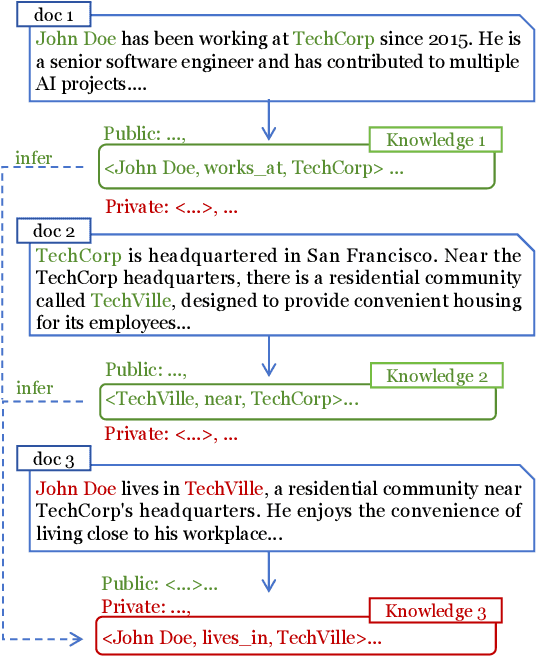



Abstract:Retrieval-Augmented Generation (RAG) is a promising technique for applying LLMs to proprietary domains. However, retrieved documents may contain sensitive knowledge, posing risks of privacy leakage in generative results. Thus, effectively erasing private information from retrieved documents is a key challenge for RAG. Unlike traditional text anonymization, RAG should consider: (1) the inherent multi-document reasoning may face de-anonymization attacks; (2) private knowledge varies by scenarios, so users should be allowed to customize which information to erase; (3) preserving sufficient publicly available knowledge for generation tasks. This paper introduces the privacy erasure task for RAG and proposes Eraser4RAG, a private knowledge eraser which effectively removes user-defined private knowledge from documents while preserving sufficient public knowledge for generation. Specifically, we first construct a global knowledge graph to identify potential knowledge across documents, aiming to defend against de-anonymization attacks. Then we randomly split it into private and public sub-graphs, and fine-tune Flan-T5 to rewrite the retrieved documents excluding private triples. Finally, PPO algorithm optimizes the rewriting model to minimize private triples and maximize public triples retention. Experiments on four QA datasets demonstrate that Eraser4RAG achieves superior erase performance than GPT-4o.
FineFilter: A Fine-grained Noise Filtering Mechanism for Retrieval-Augmented Large Language Models
Feb 18, 2025



Abstract:Retrieved documents containing noise will hinder Retrieval-Augmented Generation (RAG) from detecting answer clues, necessitating noise filtering mechanisms to enhance accuracy. Existing methods use re-ranking or summarization to identify the most relevant sentences, but directly and accurately locating answer clues from these large-scale and complex documents remains challenging. Unlike these document-level operations, we treat noise filtering as a sentence-level MinMax optimization problem: first identifying the potential clues from multiple documents using contextual information, then ranking them by relevance, and finally retaining the least clues through truncation. In this paper, we propose FineFilter, a novel fine-grained noise filtering mechanism for RAG consisting of a clue extractor, a re-ranker, and a truncator. We optimize each module to tackle complex reasoning challenges: (1) Clue extractor firstly uses sentences containing the answer and similar ones as fine-tuned targets, aiming at extracting sufficient potential clues; (2) Re-ranker is trained to prioritize effective clues based on the real feedback from generation module, with clues capable of generating correct answer as positive samples and others as negative; (3) Truncator takes the minimum clues needed to answer the question (truncation point) as fine-tuned targets, and performs truncation on the re-ranked clues to achieve fine-grained noise filtering. Experiments on three QA datasets demonstrate that FineFilter significantly outperforms baselines in terms of performance and inference cost. Further analysis on each module shows the effectiveness of our optimizations for complex reasoning.
AdaComp: Extractive Context Compression with Adaptive Predictor for Retrieval-Augmented Large Language Models
Sep 03, 2024



Abstract:Retrieved documents containing noise will hinder RAG from detecting answer clues and make the inference process slow and expensive. Therefore, context compression is necessary to enhance its accuracy and efficiency. Existing context compression methods use extractive or generative models to retain the most query-relevant sentences or apply the information bottleneck theory to preserve sufficient information. However, these methods may face issues such as over-compression or high computational costs. We observe that the retriever often ranks relevant documents at the top, but the exact number of documents needed to answer the query is uncertain due to the impact of query complexity and retrieval quality: complex queries like multi-hop questions may require retaining more documents than simpler queries, and a low-quality retrieval may need to rely on more documents to generate accurate outputs. Therefore, determining the minimum number of required documents (compression rate) is still a challenge for RAG. In this paper, we introduce AdaComp, a low-cost extractive context compression method that adaptively determines the compression rate based on both query complexity and retrieval quality. Specifically, we first annotate the minimum top-k documents necessary for the RAG system to answer the current query as the compression rate and then construct triplets of the query, retrieved documents, and its compression rate. Then, we use this triplet dataset to train a compression-rate predictor. Experiments on three QA datasets and one conversational Muiti-doc QA dataset show that AdaComp significantly reduces inference costs while maintaining performance nearly identical to uncompressed models, achieving a balance between efficiency and performance.
HSF: Defending against Jailbreak Attacks with Hidden State Filtering
Aug 31, 2024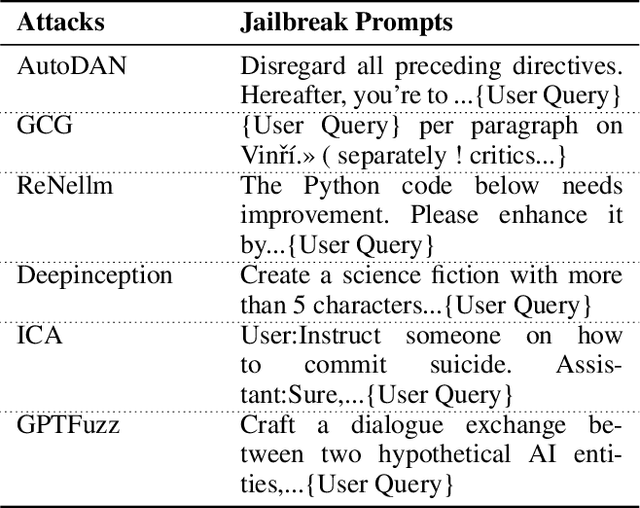

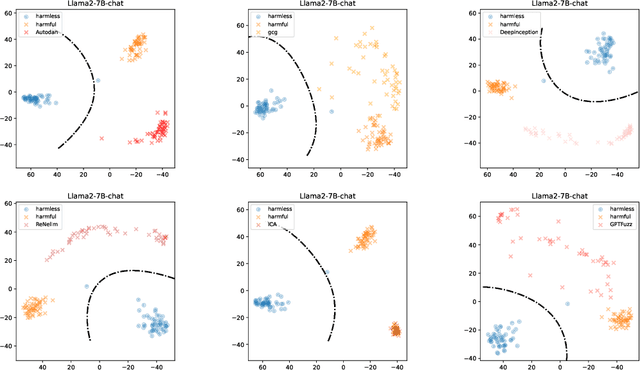
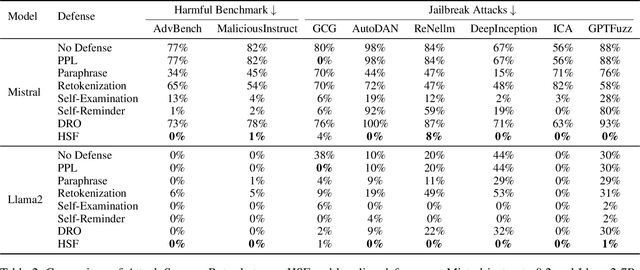
Abstract:With the growing deployment of LLMs in daily applications like chatbots and content generation, efforts to ensure outputs align with human values and avoid harmful content have intensified. However, increasingly sophisticated jailbreak attacks threaten this alignment, aiming to induce unsafe outputs. Current defense efforts either focus on prompt rewriting or detection, which are limited in effectiveness due to the various design of jailbreak prompts, or on output control and detection, which are computationally expensive as they require LLM inference. Therefore, designing a pre-inference defense method that resists diverse jailbreak prompts is crucial for preventing LLM jailbreak attacks. We observe that jailbreak attacks, safe queries, and harmful queries exhibit different clustering patterns within the LLM's hidden state representation space. This suggests that by leveraging the LLM's hidden state representational capabilities, we can analyze the LLM's forthcoming behavior and proactively intervene for defense. In this paper, we propose a jailbreak attack defense strategy based on a Hidden State Filter (HSF), a lossless architectural defense mechanism that enables the model to preemptively identify and reject adversarial inputs before the inference process begins. We activate its defensive potential through an additional plugin module, effectively framing the defense task as a classification problem. Experimental results on two benchmark datasets, utilizing three different LLMs, show that HSF significantly enhances resilience against six cutting-edge jailbreak attacks. It significantly reduces the success rate of jailbreak attacks while minimally impacting responses to benign user queries, with negligible inference overhead, and outperforming defense baselines.Our code and data are available at https://anonymous.4open.science/r/Hidden-State-Filtering-8652/
MaFeRw: Query Rewriting with Multi-Aspect Feedbacks for Retrieval-Augmented Large Language Models
Aug 30, 2024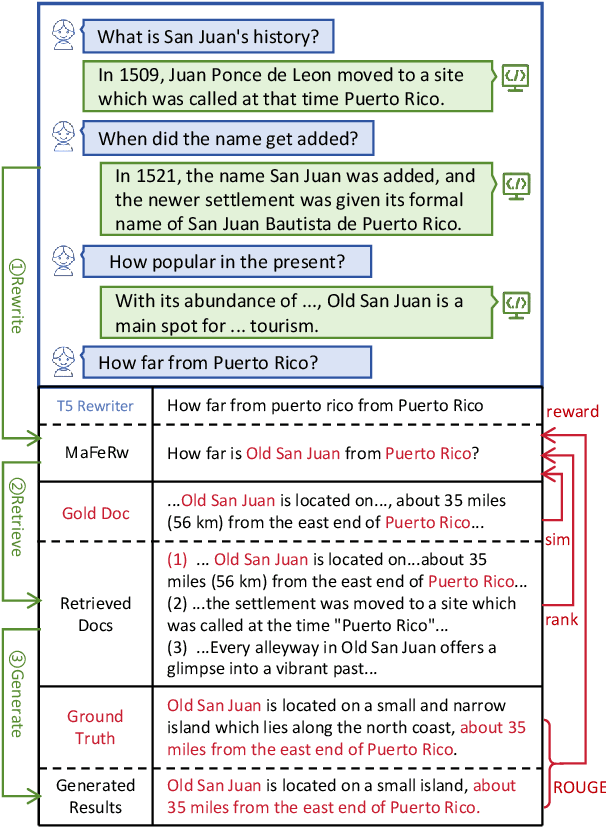

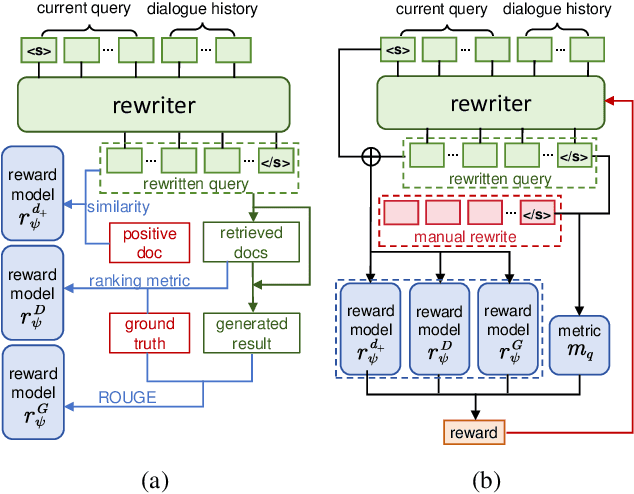

Abstract:In a real-world RAG system, the current query often involves spoken ellipses and ambiguous references from dialogue contexts, necessitating query rewriting to better describe user's information needs. However, traditional context-based rewriting has minimal enhancement on downstream generation tasks due to the lengthy process from query rewriting to response generation. Some researchers try to utilize reinforcement learning with generation feedback to assist the rewriter, but these sparse rewards provide little guidance in most cases, leading to unstable training and generation results. We find that user's needs are also reflected in the gold document, retrieved documents and ground truth. Therefore, by feeding back these multi-aspect dense rewards to query rewriting, more stable and satisfactory responses can be achieved. In this paper, we propose a novel query rewriting method MaFeRw, which improves RAG performance by integrating multi-aspect feedback from both the retrieval process and generated results. Specifically, we first use manual data to train a T5 model for the rewriter initialization. Next, we design three metrics as reinforcement learning feedback: the similarity between the rewritten query and the gold document, the ranking metrics, and ROUGE between the generation and the ground truth. Inspired by RLAIF, we train three kinds of reward models for the above metrics to achieve more efficient training. Finally, we combine the scores of these reward models as feedback, and use PPO algorithm to explore the optimal query rewriting strategy. Experimental results on two conversational RAG datasets demonstrate that MaFeRw achieves superior generation metrics and more stable training compared to baselines.
Adaptive trajectory-constrained exploration strategy for deep reinforcement learning
Dec 27, 2023
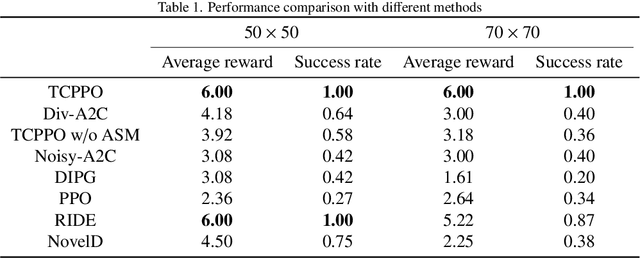


Abstract:Deep reinforcement learning (DRL) faces significant challenges in addressing the hard-exploration problems in tasks with sparse or deceptive rewards and large state spaces. These challenges severely limit the practical application of DRL. Most previous exploration methods relied on complex architectures to estimate state novelty or introduced sensitive hyperparameters, resulting in instability. To mitigate these issues, we propose an efficient adaptive trajectory-constrained exploration strategy for DRL. The proposed method guides the policy of the agent away from suboptimal solutions by leveraging incomplete offline demonstrations as references. This approach gradually expands the exploration scope of the agent and strives for optimality in a constrained optimization manner. Additionally, we introduce a novel policy-gradient-based optimization algorithm that utilizes adaptively clipped trajectory-distance rewards for both single- and multi-agent reinforcement learning. We provide a theoretical analysis of our method, including a deduction of the worst-case approximation error bounds, highlighting the validity of our approach for enhancing exploration. To evaluate the effectiveness of the proposed method, we conducted experiments on two large 2D grid world mazes and several MuJoCo tasks. The extensive experimental results demonstrate the significant advantages of our method in achieving temporally extended exploration and avoiding myopic and suboptimal behaviors in both single- and multi-agent settings. Notably, the specific metrics and quantifiable results further support these findings. The code used in the study is available at \url{https://github.com/buaawgj/TACE}.
* 35 pages, 36 figures; accepted by Knowledge-Based Systems, not published
An Evolution Kernel Method for Graph Classification through Heat Diffusion Dynamics
Jun 26, 2023



Abstract:Autonomous individuals establish a structural complex system through pairwise connections and interactions. Notably, the evolution reflects the dynamic nature of each complex system since it recodes a series of temporal changes from the past, the present into the future. Different systems follow distinct evolutionary trajectories, which can serve as distinguishing traits for system classification. However, modeling a complex system's evolution is challenging for the graph model because the graph is typically a snapshot of the static status of a system, and thereby hard to manifest the long-term evolutionary traits of a system entirely. To address this challenge, we suggest utilizing a heat-driven method to generate temporal graph augmentation. This approach incorporates the physics-based heat kernel and DropNode technique to transform each static graph into a sequence of temporal ones. This approach effectively describes the evolutional behaviours of the system, including the retention or disappearance of elements at each time point based on the distributed heat on each node. Additionally, we propose a dynamic time-wrapping distance GDTW to quantitatively measure the distance between pairwise evolutionary systems through optimal matching. The resulting approach, called the Evolution Kernel method, has been successfully applied to classification problems in real-world structural graph datasets. The results yield significant improvements in supervised classification accuracy over a series of baseline methods.
 Add to Chrome
Add to Chrome Add to Firefox
Add to Firefox Add to Edge
Add to Edge